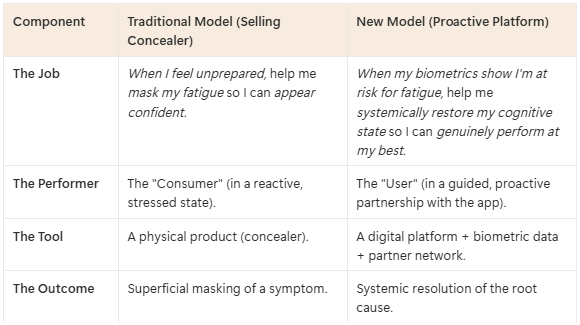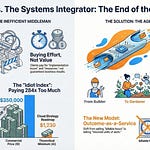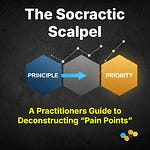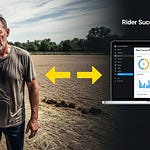Please Participate
I’m doing some innovation research and could use your help. In exchange, I will gladly give you FREE access to my JTBD Masterclass and 6 other courses that come with it. It’ll take less than 10 minutes of your time.
This is completely anonymous unless you opt-in for the Masterclass
Click here to participate: https://web.jtbd.one/inno-survey
Introduction: The Illusion of Innovation in the Beauty Industry
Let’s be honest. For the last fifty years, “innovation” in the beauty industry has been a remarkable illusion.
We’ve seen new shades, new “active ingredients,” and new celebrity faces. We’ve gone from matte to gloss, from powders to serums, from “clean” to “clinical.” But what has fundamentally changed?
The core business model is identical to the one your grandmother grew up with: manufacture a physical substance, put it in an attractive container, spend a fortune on marketing to create an emotional association, and sell it at a massive markup.
This cycle of incrementalism—repackaging the same basic solutions over and over—is a sign of a stagnant industry. It’s trapped in a “red ocean” of competition, fighting over fractions of market share while completely ignoring the real opportunity.
Here’s the problem: beauty brands are so focused on the product they’re selling that they’ve forgotten the job the customer is hiring it to do.
That’s where we’re going to focus.
3 Different Twists on this Same Topic
Downloadable PDFs
The core thesis of this post is simple: The future of your brand isn’t about better makeup; it’s about leveraging your data to deliver the feeling that makeup promises.
It’s about delivering confidence. Preparedness. Peak performance.
If you’re a leader at a consumer brand, you are sitting on a goldmine of data that you’re probably just using for retargeting ads. You see purchase history, quiz results, site behavior, and maybe even app interactions. You likely know more about your customer’s anxieties and aspirations than they do.
What if you stopped using that data to sell one more lipstick and started using it to build an unbeatable, high-margin business that actually solves your customer’s underlying problem?
We’re not just talking about personalization. We’re talking about a complete business model transformation—from selling cosmetics to selling cognitive enhancement.
In this deep dive, we’re going to tear down the entire beauty industry from first principles. We will systematically refute the assumptions that keep brands trapped in the past. Then, we’ll build, from the ground up, a playbook of three actionable, data-driven business models that you can start exploring today.
(If you’re looking for a quick visual overview of this concept, I’ve recorded a complementary video on my YouTube channel that breaks down the core idea, which I’ll link at the end.)
This is an 8,000-word guide for builders. Let’s get started.
The Foundational Flaw: Why the Traditional CPG Model is a Trap
Before we can build the new, we have to understand why the old is broken. The traditional CPG (Consumer Packaged Goods) model that powers the entire beauty industry is fundamentally fragile.
It’s a trap. It forces you into a game you can’t win long-term.
Here’s why:
1. Your Business is Built on High-Friction Acquisition
The CPG model is a war of attrition for attention. Your primary cost center isn’t R&D; it’s marketing. You’re forced to spend staggering amounts of money on Facebook ads, influencer campaigns, and retail slotting fees just to get a customer to make a first purchase.
You’re not just competing with other brands; you’re competing with Netflix, with newsfeeds, with every other distraction for a sliver of your customer’s brain space. This Customer Acquisition Cost (CAC) is a crushing, permanent tax on your business.
2. Your Customers Have Zero Switching Costs
What really keeps a customer loyal to your $40 foundation?
Is it a truly irreplaceable, proprietary formula? Almost never. Is it a deep, personal relationship? Unlikely.
The truth is, for 99% of brands, there are no real switching costs. A customer can try a competitor’s product tomorrow with zero friction, lured by a splashier ad, a better price, or a different influencer.
This means you have to re-acquire your own customers over and over again. Your business isn’t building a defensible asset; it’s a leaky bucket you have to constantly refill.
3. You’re Trapped in a Commodity-Margin Game
When you sell a physical product, you are in a commodity business, whether you admit it or not.
You’re at the mercy of supply chains, raw material costs, and manufacturing partners. Your competitor can (and will) source a similar formula from the same lab, put it in a different bottle, and undercut your price.
The only way to justify your margin is through the illusion of “brand.” But “brand” as a moat is weaker than it’s ever been. Consumers are skeptical, and new D2C brands can spin up a “premium” brand identity in a weekend.
This entire model is a race to the bottom. It’s high-cost, low-loyalty, and low-moat.
The only way out is to change the game. You have to build a moat that can’t be copied by a new D2C brand or a behemoth like L’Oréal. That moat isn’t your product. It’s your data.
It’s the unique, compounding insight you have into your customer’s life, and your ability to use that insight to get a job done better than anyone else.
To do that, we have to go deeper. We have to ask a question the industry has ignored for decades: What is the real job a customer is hiring “beauty” to do?
First-Principles Deconstruction: What is the “Job” of a Beauty Product?
The most powerful way to find a breakthrough innovation is to stop looking at what everyone else is doing and deconstruct the problem to its fundamental truths. This is First-Principles Thinking.
We’re going to systematically identify the core assumptions the entire beauty industry is built on, challenge them, and replace them with validated truths.
This is where you’ll find your multi-trillion dollar opportunity.
Assumption #1: The Job is to “Cover Imperfections”
The Conventional Wisdom: A customer buys concealer to “conceal” a blemish. They buy foundation to “even out” their skin tone. They buy mascara to “lengthen” their lashes. The job is functional and cosmetic.
The Deconstruction: This is the most dangerous and laziest assumption in the industry. It confuses the action with the outcome.
Why does the customer want to cover the blemish? Because they have a big presentation on Zoom and they feel self-conscious. Why do they want to even their skin tone? Because they’re going on a first date and want to feel confident.
The physical “imperfection” is just a trigger. The real job is emotional, psychological, and situational.
When you dig into the “Job-to-be-Done” (JTBD), you find the customer isn’t trying to look a certain way. They are trying to feel a certain way, to perform a certain way, or to be perceived a certain way in a specific context.
The Fundamental Truth: The real job is to increase confidence and improve self-perception in a moment that matters.
No one is hiring your product to just sit at home alone and “have concealed blemishes.” They are hiring it to be a piece of armor, a tool that helps them transition from their current state (”anxious,” “unprepared,” “tired”) to their desired state (”confident,” “poised,” “ready”).
This one shift in perspective changes everything. If the job is “deliver confidence,” suddenly a physical product is just one possible solution—and likely not the most effective one.
Assumption #2: The Solution Must Be a Physical Product
The Conventional Wisdom: We are a cosmetics company. We sell things in tubes, jars, and palettes. To innovate, we must create a new physical thing.
The Deconstruction: This is a catastrophic failure of imagination. It’s the equivalent of Kodak thinking their job was to sell “film” instead of “letting people preserve memories.”
If the job is to “deliver confidence before a big meeting,” what’s the best tool to get that job done?
Solution A (The Old Way): A high-coverage concealer.
Result: The customer’s blemish is covered, but they’re still nervous about the meeting. The core anxiety isn’t resolved.
Solution B (The New Way): A 3-minute guided audio meditation + breathing exercise, delivered via your brand’s app, specifically designed for pre-meeting focus.
Result: The customer’s cortisol levels drop. Their mind clears. They feel centered and ready. The actual job gets done completely.
The physical product is a low-fidelity, indirect solution to the real problem. In a data-rich world, a personalized service or insight is a far more direct, high-fidelity solution.
The Fundamental Truth: The solution is whatever tool gets the job done most effectively. In the 21st century, this is often a digital service, a piece of content, or a personalized insight—not a physical good.
Assumption #3: The Customer is Buying “Beauty”
The Conventional Wisdom: Our customers are passionate about “beauty.” They love the artistry, the ritual, the trends. We must cater to this “beauty” identity.
The Deconstruction: This assumption confuses the hobbyist with the mainstream customer. Yes, a small (but loud) segment of your audience loves the process of beauty as a hobby. But for the vast majority of your customers, it’s a chore.
It’s a necessary, and often stressful, part of a larger job they are trying to do.
Think about it:
The busy executive isn’t “doing her makeup”; she’s “getting ready for work.”
The new mom isn’t “perfecting her skincare routine”; she’s “trying to look and feel human on 2 hours of sleep.”
The college student isn’t “expressing himself”; he’s “trying to look good for a party.”
They aren’t buying “beauty.” They are hiring a tool to help them feel ready to perform better in their life.
The Fundamental Truth: The customer is hiring a tool to help them manage their cognitive and emotional state. The job is performance enhancement, not artistry.
This is the biggest leap. The beauty industry isn’t in the cosmetics business. It’s in the cognitive enhancement business. It’s just been using very primitive tools to do the job.
Assumption #4: The Customer Wants More Product Options
The Conventional Wisdom: Customers crave choice. Innovation means launching 50 shades of foundation, 10 new lipstick colors every season, and a new 7-step skincare system.
The Deconstruction: This is a classic example of a company pushing its own internal metrics (SKU velocity, “newness”) onto the customer. In reality, you are just causing decision fatigue.
When a customer is already stressed and trying to “get ready for work,” the last thing they want is a complex, 10-product routine. They don’t want “options.” They want a result.
The real job is to quickly and reliably achieve a desired emotional state. More products means more friction, more time, and more cognitive load.
This is what all the “clean” and “simple” brands got right, but only by accident. They reduced the product line and customers felt relief. The next step is to get the job done with no physical product at all.
The Fundamental Truth: The customer wants fewer, better decisions. The ultimate solution gets the job done with the least amount of friction, time, and effort. A single, perfect, personalized insight is infinitely more valuable than a thousand product options.
Assumption #5: The Brand Relationship is Built on Marketing
The Conventional Wisdom: Our brand is our moat. We build this moat with beautiful imagery, relatable influencers, and a compelling mission statement.
The Deconstruction: This is the CPG trap again. You’re building a “brand” based on projected identity rather than functional utility. This kind of brand is incredibly fragile. It can be destroyed by one bad PR cycle or simply replaced by a new, cooler brand next week.
A real, defensible brand—a true moat—isn’t built on what you say. It’s built on what you do.
A moat is when your product or service becomes so deeply integrated into your customer’s life that switching away from it would cause real pain.
Amazon’s moat is Prime (logistics + network).
Apple’s moat is iOS (ecosystem + switching costs).
Google’s moat is its index (data + process).
Your beauty brand has no moat. But it could.
The Fundamental Truth: A real moat is built on utility and integration. It’s created when your service becomes the default, indispensable tool for getting a critical job done. This is achieved through a data feedback loop, not a marketing campaign.
Establishing the New Foundation: The Core Truths of the “Beauty” Job
Let’s synthesize what we’ve learned. We’ve stripped away the assumptions of the last century. Here are the fundamental truths we’re left with:
The Core Job: The ultimate job is to manage and enhance one’s emotional and cognitive state to be better prepared for important moments in life.
The Context: The “problem” isn’t a physical imperfection; it’s a trigger for an emotional or psychological need (anxiety, lack of confidence, fatigue).
The Solution: The best solution is the one that gets the job done most directly and efficiently. This is almost always a data-driven, personalized service or insight, not a physical product.
The Value: The customer doesn’t want “options.” They want outcomes. They want confidence, focus, and a feeling of preparedness, delivered with zero friction.
The Moat: A defensible business is not built on marketing. It is built on a compounding data asset that delivers ever-increasing utility, creating deep, functional integration with the customer’s life.
This is our new foundation. Now, let’s build on it.
The Playbook: Three Novel Business Models Built on First Principles
This is where the theory becomes practice. Here are three detailed, actionable business models you could build—starting today—by leveraging the customer data you already have.
These models are designed to elevate the level of abstraction, getting the real job done better, faster, and with fewer visible features.
Model 1: The Cognitive Enhancement Service (Working Today)
This is the most direct application of our findings. You stop being a “product” company and become a high-margin “service” company. The makeup becomes the low-margin gateway to the high-margin, sticky subscription.
The Concept: Your app isn’t just a “store.” It’s a “personal performance partner.”
Based on a customer’s purchase data, quiz results, and simple app-based check-ins, you build a predictive model of their life’s “moments.”
How it Works (Example):
Data Insight: Your system notices a customer (let’s call her Sarah) consistently buys high-coverage concealer and “long-wear” products every 3-4 months. From a quiz, you know she’s a mid-level manager in finance. You can predict with high confidence that these purchases correlate with major presentations or quarterly reviews.
The Old Model: You send her an email: “Running low on concealer? Buy now!”
The New Model: Two days before her typical “high-stress” purchase, your app sends a push notification:
“Hey Sarah, looks like you might have a big week ahead. We’ve unlocked two 5-minute audio guides in your app: ‘Pre-Meeting Focus’ and ‘How to Speak with Confidence on Zoom.’ Good luck.”
The Upsell: Sarah uses the guides and loves them. She feels better than the concealer ever made her feel. At the end of the guide, the app offers her a subscription:
“Get access to your full ‘Personal Performance’ library—including stress-management routines, cognitive nutrition guides, and sleep-enhancement sounds—for $19.99/month.”
The Business Model: You’re no longer in the 20% margin game of physical goods. You are in the 90%+ margin game of digital content and services. Your physical products become a customer acquisition channel for your real business: a high-retention subscription service that delivers cognitive and emotional enhancement.
Doblin’s 10 Types Integration: This model is defensible because it’s not just one innovation; it’s three layered together:
Business Model: You shift from one-off transactions to a recurring subscription revenue stream.
Service: You offer a valuable, non-physical service (content, guides) that complements your physical product.
Process: You use your proprietary data-linking process to predict customer needs before they happen, creating a magical, proactive experience.
Model 2: The Proactive Wellness Platform (The Near Future)
This model elevates the level of abstraction. Instead of reacting to the customer’s stress, you proactively get the job done before the problem even begins.
The Concept: You get the job of “looking refreshed and confident” done at a much higher level—by managing the inputs (sleep, stress, nutrition) rather than masking the outputs (fatigue, blemishes).
How it Works (Example):
Data Insight: Your app integrates (with permission) with the customer’s health tracker (Oura Ring, Apple Watch).
The Proactive Intervention: Your system sees the customer had a 4.5-hour night of broken sleep. Their heart rate variability is low. They are, objectively, going to feel and look terrible.
The Old Model: The customer wakes up, sees their tired face, and frantically applies extra-strength concealer and eye-brightening cream (your products).
The New Model: The customer wakes up to a notification:
“We saw you had a rough night. To get you ready for the day, here’s a 3-step plan:
Hydrate: Start with 16oz of water + electrolytes.
De-puff: Try this 5-minute cold-therapy facial massage (video guide).
Boost: We’ve partnered with [Brand] to have a ‘Cognitive Clarity’ tea delivered to you by 8 AM. Click to confirm.”*
The job—”help me feel and look ready for my day despite my poor sleep”—is now accomplished at a systemic level. The concealer becomes the solution of last resort, not the first line of defense.
The Business Model: You become a wellness-as-a-service (WaaS) platform. Your revenue comes from your core subscription, but you also open up a new, massive revenue stream through Network innovation—taking a percentage of affiliate sales and partnerships from all the other non-competing brands (like the tea company) that you integrate into your platform.
Creativity Matrix: Deconstructing the “Proactive Wellness” Job
Model 3: The B2B Performance Marketplace (The New Abstraction)
This is the ultimate elevation of your business. You realize your most valuable asset isn’t your customer list; it’s the predictive engine you’ve built.
The Concept: You’ve spent years building a data engine that can correlate purchasing behavior, app usage, and (in Model 2) biometrics with real-world emotional and cognitive states. This engine is a “Corporate Performance Predictor,” and it’s far more valuable to other businesses than it is to consumers.
How it Works (Example):
The Pivot: You stop (or spin off) your consumer-facing brand. Your new company’s mission is “We help every employee perform at their best.”
The Product: You sell a B2B SaaS platform to Fortune 500 companies for their corporate wellness programs.
The Service: Your platform integrates with company calendars and (on an opt-in basis) employee wellness apps.
It identifies an employee with three back-to-back major presentations and a high-stress score.
It proactively pushes a 10-minute “burnout prevention” guide through the company’s Slack.
It suggests a “focus” playlist for the hour before their presentation.
It even integrates with the corporate cafeteria to recommend a brain-boosting lunch.
The Business Model: You are now a B2B SaaS company with a massive Total Addressable Market (TAM). You’ve left the red ocean of CPG completely. The “job” has been elevated from “help me look good” (consumer) to “help our team win” (B2B).
You’ve created an entirely new category—a non-physical, data-driven solution to a problem that is currently being “solved” with free donuts and generic mindfulness apps.
Building Your Moat with Doblin’s 10 Types of Innovation
Now, the most important question: How do you make these new models defensible? How do you stop a competitor from just copying your app?
The answer is that you don’t rely on one single innovation. You layer them. This is where you use Doblin’s 10 Types of Innovation as a checklist to build a fortress around your business.
A traditional beauty brand only competes on two, maybe three, of the ten types:
Product Performance: (e.g., “Our serum is 10% more effective.”)
Brand: (e.g., “Our marketing is cooler.”)
Channel: (e.g., “We’re exclusive to Sephora.”)
This is why they are so fragile.
Your new data-driven business (like Model 2) builds its moat by combining innovations from all three categories: Configuration, Offering, and Experience.
Your Configuration Moat (The “Back End”):
Profit Model: You’re on a Subscription model, while they’re on a transactional one. Your cash flow is predictable and compounds.
Network: You’ve built a Network of wellness partners (tea companies, trackers) that all share data and revenue, strengthening your platform with every new partner.
Process: You have a proprietary Process for using your data to generate proactive insights. This is your “secret sauce” that gets smarter with every user.
Your Offering Moat (The “Product”):
Service: Your core “product” is a Service (insights, content, guidance), which is infinitely scalable, unlike their physical inventory.
Your Experience Moat (The “Front End”):
Customer Engagement: Your relationship isn’t transactional. It’s a deep, daily Engagement driven by proactive, personalized utility. You’re an indispensable partner; they’re just a “brand.”
A competitor can’t beat you by just launching a new lipstick. To even compete, they would have to completely re-organize their entire company—change their profit model, build a data science team, and create a partner network.
You’re not just in a different league; you’re playing a different sport.
Conclusion: Your Data is the Product
The beauty industry is on the verge of a massive disruption. The brands that survive—and thrive—in the next decade will be the ones that have the courage to stop thinking like cosmetics companies.
They will be the ones who realize they aren’t selling makeup. They are selling confidence. They aren’t selling skincare. They are selling performance.
You are sitting on the single most valuable asset you could possibly own: a direct, digital-first relationship with your customer and the data that comes with it.
Stop using that data to just market the past. Use it to build the future.
Your data isn’t a marketing tool. Your data is the product.
Stop selling them another jar. Start selling them an outcome.
I make content like this for a reason. It’s not just to predict the future; it’s to show you how to think about it from first principles. The concepts in this blueprint are hypotheses—powerful starting points. But in the real world, I work with my clients to de-risk this process, turning big ideas into capital-efficient investment decisions, every single time.
Follow me on 𝕏: https://x.com/mikeboysen
If you’re interested in inventing the future as opposed to fiddling around the edges, feel free to contact me. My availability is limited.
Mike Boysen - www.pjtbd.comDe-Risk Your Next Big Idea
Masterclass: Heavily Discounted $67
My Blog: https://jtbd.one
Book an appointment: https://pjtbd.com/book-mike
Join our community: https://pjtbd.com/join











